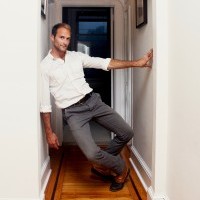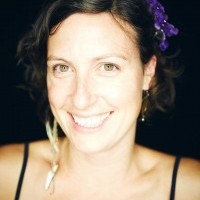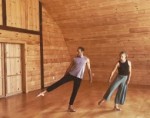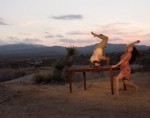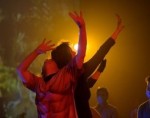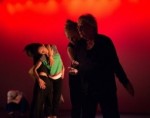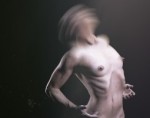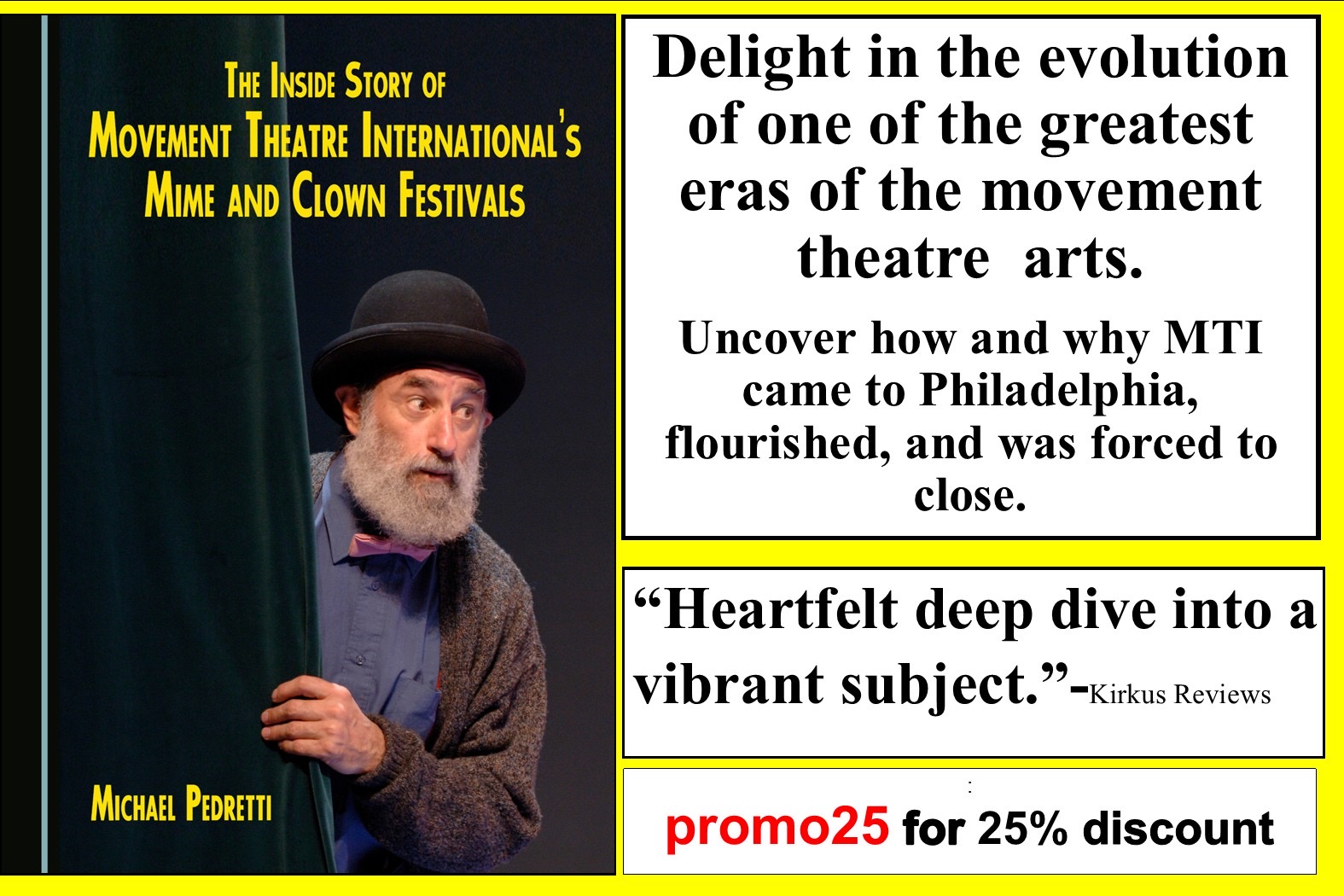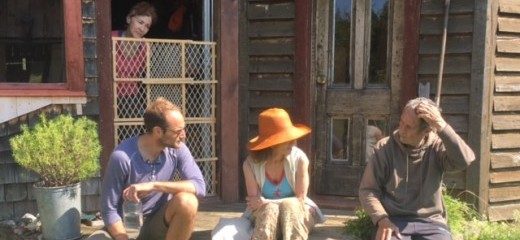
Lessons from the Backyard
by Megan Bridge and Beau Hancock
Pictured above: Lisa Nelson (in doorway), Beau Hancock, Cathy Weis, Steve Paxton (L to R on step)
Beau: I’m writing from Philadelphia, Pennsylvania, having just returned from Plovdiv, Bulgaria, where Megan Bridge and I performed our duet, The Backyard, at “Spotlight: USA: A Platform of American Dance.” I’m feeling the shock of travel, the shifting of awareness from the new, back to the familiar. Plovdiv is an ancient place, littered with Roman ruins, Turkish-style mosques, remnants of Soviet-era architecture, and winding cobblestone streets. But this piece is not about that. Let’s back up.
Megan: Last summer, July 2017 to be exact, Beau and I traveled to northern Vermont for a week-long period of research with Steve Paxton and Lisa Nelson in their studio at Mad Brook Farm. It felt like a pilgrimage. I’ve read about these people in history books and magazine articles, but never imagined I’d be standing before them, much less spending a week getting cozy inside their studio, inside their brains, inside their working processes. Through email correspondence, I worked for two years on putting this project together.
It all started when I was choreographing Dust, an opera by Robert Ashley. I researched choreographers who had worked with Ashley’s music, and came across Steve and Lisa’s PA RT, a 45-minute improvised duet that they toured from 1978 to 2002. PA RT is danced to Ashley’s Private Parts. I wanted to learn it … partially because I love dancing to Ashley’s music and wanted to do it again. But more centrally because I felt an affinity with Steve and Lisa’s approach: in particular with the way they seemed to be responding somatically to the sonic material as material, in a phenomenological sense. And, perhaps most simply, the perpetual student in me wanted to get in the room with and learn from these masters.
B: But how do you “learn” someone’s improvisation? How do you capture the essence of an artist’s improvised work, especially when the central structure for that work is that it be always “new”? How do you navigate a performance landscape that is built on the felt experience and idiosyncratic choices of its makers? Megan and I knew that this project would be fraught with questions about translation. I was both frightened and thrilled, in equal measure, by these questions.
M: In preparation for our trip, Beau and I met in a studio in Philly for about 30 hours, watching versions of PA RT that Steve and Lisa had shared with us from 1979 (Western Front, Vancouver BC) and 1983 (Danspace, New York City). Then we practiced our own version of the score, keeping Steve and Lisa’s solo/duet/solo/duet structure. Sometimes we’d run the piece three times in a row, trying it on, bumping around inside it, learning what it felt like to copy, emulate, or purposely veer away from choices that our as-yet disembodied teachers on video had made.
B: We invited three artists and improvisers, whose personal research we felt aligned with this project, to work with us. Robert Bingham, David Brick, and Leslie Elkins joined us in the studio to offer suggestions for how we might approach this task of entering PA RT, provided exercises and methods that might help frame our experience and approach to a duet improvisation, and offered us an outside perspective on what was happening when we were improvising. These extra eyes in the studio were invaluable, and prepared us for the week spent working, laughing, and talking with Steve and Lisa.
M: We arrived in Newport, Vermont, after the eight-hour drive from Philly, checked into our Airbnb, grabbed food, and headed straight over to Mad Brook Farm, arriving at about 7:15 pm. We timidly said our hellos, warmed up a bit, and jumped right into a run-through of our version of their dance. Afterwards, we spoke with Steve and Lisa just a bit, but decided to keep most of the chatting about the work for the next morning when we were fresh. It was all a bit scary and exciting to encounter these two legends, and I was so glad to get over the hurdle of the first meeting and first run. Steve and Lisa are wonderfully warm, generous, and brilliant. She is by far the more talkative; when he speaks there is a playful directness. They both smile often.
B: Mad Brook Farm is magical. Surrounded by the Green Mountains, it includes a large wooden studio that we would spend the next week occupying, lounging on sofas, reading and writing in our break periods, wandering the grounds with their wild-looking garden that Lisa tends in the same casual but purposeful way she dances. She was the host, setting our schedule, filming our performances of the work, making sure we had all that we needed. Steve’s presence was more reserved—warm but unassuming. After the first run, he commented to me on the adventure of performing this work.
M: They live in the back of the studio, and Lisa also has her own detached cabin. There is wifi, but no cell phone service (they have a landline). Cathy Weis has a house up the hill, and a bit further up, Deborah Hay was visiting. Also sharing their yard are two cats (Paris and Limbo), three pigs (Lisa tends with a neighbor), seventeen chickens, and their wildly sprawling vegetable garden, full of tomatoes, lettuce, fennel, cilantro, basil, scapes, and more.
The second day we talked, danced, and took a long lunch break followed by more conversation and watching videos of Steve and Lisa performing PA RT in 1979 and 1998. Our talk circled around beauty and our values as performer/improvisers, about what they were working on, physically, in their practices at the time.
B: Lisa described how her use of the eyes has been an important component in her dancing, using them as limbs. This method resonated with me, having been interested in how focus directs choice-making and compositional design in my own work. I continue to work with this suggestion, feeling my eyes touch the space around me as I improvise. I’ve found that it encourages a new kind of engagement with the space that goes beyond seeing, and transforms into connection.
Steve described his slow opening walk, the role that I dance in our version of the work. It comes from Aikido, which Steve studied and which informs his use of the energetic body. And even though I decided to start seated on stage rather than shifting slowly through the audience as Steve did in the original, his instructions on recognizing and utilizing specific energy channels through the body have stayed with me as I continue to dance this piece.
M: One morning, Steve led us in an Aikido warm up, working specifically on “Ki” pointing, talking about energy’s origin in the pelvic center and how it flows through the body in whatever pathway is “pointing.” We started with the pinky and ring-finger-side of the hand, and talked about how that energy flow connects down through the back of the arm and into the back and pelvis.
Lisa said that when she is improvising, she is busy measuring time: how long it takes for something to materialize as a sensation, and then to become visible. That’s what I feel like we are doing with this duet. We measure time, and with each performance the underlying “why” of the project gets drawn in with a little more detail. The work is becoming itself as we perform it. We are letting go of certain aspects of Steve and Lisa’s "rules" that we find don’t apply to us, and other things are arising in their place as the piece reveals its own dramaturgy to us.
B: In our earlier rehearsals, David had brought up the idea that what we are doing is a palimpsest, an effaced manuscript written over but still bearing the traces of the original. This is how we landed on The Backyard (the name of the second movement of Ashley's Private Parts), a dance that bears traces of PA RT, carries on elements of Steve and Lisa’s work, but has its own character. That character continues to crystallize. Our performances in the American Dance Abroad showcase in Plovdiv forced Megan and me to question parts of the performance that are no longer relevant. For example, we had included an addendum to the title—(after Paxton/Nelson’s PA RT, 1978-2002)—which now feels cumbersome and unnecessary.
M: All the layers of learning that we’ve done, and continue to do, inside this process feel deeply embedded within The Backyard. We keep referring to our early sessions with David, Robert, and Leslie, even now as we continue to perform the work.
Our session with Leslie, after Vermont and just before performing the duet in public for the first time, was incredibly helpful because we needed strategies for how to deal with adrenaline in performance. She introduced the idea of “zero pitch,” or sending our energy down to almost nothing, allowing things to happen, being patient and attentive, rather than trying to fill time.
It reminded me so much of our conversation at the end of the week with Steve and Lisa, where we talked about letting stillness resonate ... letting each moment play out like ripples on a pond. You throw in the stone, and watch the ripples expand until the lake goes placid again. If you keep agitating the water, you don’t get to have that experience: watching the stillness shimmer.
This research project is a program of
By Beau Hancock
April 25, 2018

